Racial Conversation as Long Table Performance
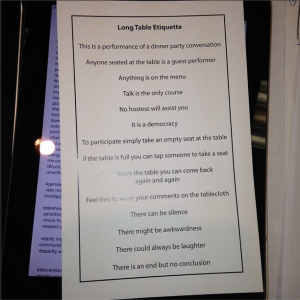
The rules of the Long Table.
Can a conversation about race be a performance? What does that simple framework shift do to the conversation? The answer: everything.
The long table conversation is a fascinating thing to watch unfold. Participants come in and out as they please. There is snacking and scribbling, mostly on topic. Some people were determined watchers, setting up camp on the chairs on the far edge of the perimeter. And others eagerly queued up in the seats closest to the table, waiting for the moment they could tap someone on the shoulder, sending that performer out and putting themselves into the conversation.
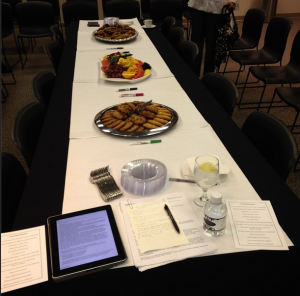
The Long Table – The Beginning
I am live tweeting a racial justice art project called the round table – no holds barred conversation. Anonymity is a part. #GIA2014
— Latoya Peterson (@LatoyaPeterson) October 14, 2014
The conversation starts off immediately. There aren’t really any awkward pauses. The presence of the table as a speaking space created a flow that participants respected. I wondered if an art project gave people license to break the rules and conventions of conversation. I felt inspired to draw a circle around an errant blueberry on the table. And at times, I felt the urge to run around, to lean over someone and circle their scribble, to interact out of order and out of place. After all, isn’t that art? Responding to stimuli?
But that will have to wait for another long table. People needed this space – stories flowed alongside tears and while this may have been intended as an art project the space morphed to accommodate mass catharsis.
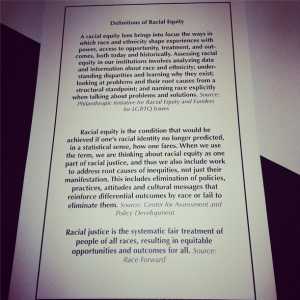
Defining racial equity.
“Equity and racial justice isn’t just a conversation. This space (the holocaust museum) is…what happens when we are not brave.” #GIA2014
— Latoya Peterson (@LatoyaPeterson) October 14, 2014
One panelist asks to decouple race from culture. Another panelist pushes back – “people always want to avoid this conversation” #GIA2014
— Latoya Peterson (@LatoyaPeterson) October 14, 2014
“People always want to put me somewhere! There is no getting away, visually, from who we are.” Performer identifies as mixed. #GIA2014
— Latoya Peterson (@LatoyaPeterson) October 14, 2014
“The millennials are the first generation in our history where there are more PoC than ever.# – performer #GIA2014
— Latoya Peterson (@LatoyaPeterson) October 14, 2014
“If we take the race box off government forms, would that stop Trayvon Martin and Mike Brown from being shot in the street?” #GIA2014
— Latoya Peterson (@LatoyaPeterson) October 14, 2014
Equity “needs a level of universal design” says performer who IDs as a grant maker with a disability. #GIA2014
— Latoya Peterson (@LatoyaPeterson) October 14, 2014
Performer identifies as south Asian, asks why we do not discuss relationships within brown communities toward each other. #GIA2014
— Latoya Peterson (@LatoyaPeterson) October 14, 2014
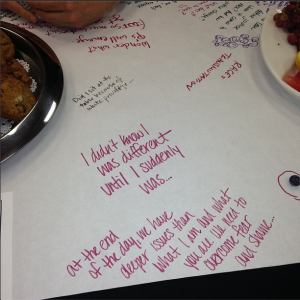
Race Scrawl.
Performer tells a story about Junot Diaz calling out white supremacy. Why can’t this happen more often? #GIA2014
— Latoya Peterson (@LatoyaPeterson) October 14, 2014
Grantmakers debating how privilege plays out in grant making: only “anointed” PoC can play, level of assimilation required. #GIA2014
— Latoya Peterson (@LatoyaPeterson) October 14, 2014
Performer IDs as a grant maker: “What power do we need to give up in order to have equity?” #GIA2014
— Latoya Peterson (@LatoyaPeterson) October 14, 2014
Performer (of color) notes: “Asians lose power in race conversations sometimes…and people with race privilege often lose power.” #GIA2014
— Latoya Peterson (@LatoyaPeterson) October 14, 2014
Performer IDs as a black male: “If I stridently advocate for PoC, do I get labeled and dealt with as an angry black man?” #GIA2014
— Latoya Peterson (@LatoyaPeterson) October 14, 2014
Performer says her Lakota grandfather asked the family to pass for survival. She is white; celebrates her heritage w/few, quietly. #GIA2014
— Latoya Peterson (@LatoyaPeterson) October 14, 2014
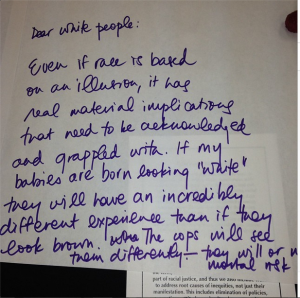
“I pass in and out of courage. I wish I had more courage.” “I’m tired of always being THE WoC. Always thinking strategically.” #GIA2014
— Latoya Peterson (@LatoyaPeterson) October 14, 2014
“I resist being cast as the angry black woman – even when I may be the only in a space. I meditate, do yoga.” The room laughs. #GIA2014
— Latoya Peterson (@LatoyaPeterson) October 14, 2014
“When … someone calls me the n word they don’t know I went to Brown or who my father is. Reminds me of my humanity in a way.” #GIA2014
— Latoya Peterson (@LatoyaPeterson) October 14, 2014
“I had someone try to use a gender neutral pronoun, and someone else corrected it thinking it was bad grammar.” #GIA2014
— Latoya Peterson (@LatoyaPeterson) October 14, 2014
White performer has biracial daughter who “can’t wait to grow up so her hair will be blond.” Epiphany: good intentions don’t help. #GIA2014
— Latoya Peterson (@LatoyaPeterson) October 14, 2014
Performer IDs as TRA – remembers wanting to be white like Alice in Wonderland. Thanks other performer for engaging. #GIA2014
— Latoya Peterson (@LatoyaPeterson) October 14, 2014
(TRA is an abbreviation for transracial adoptee.)
TRA performer has a child w white man. Child was born fair skinned. Said she was ashamed to feel relieved. #GIA2014
— Latoya Peterson (@LatoyaPeterson) October 14, 2014
Courage is a theme. How do we build racial courage? #GIA2014
— Latoya Peterson (@LatoyaPeterson) October 14, 2014
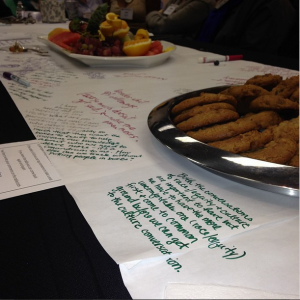
Racial Scrawl 2.
Performer weeps. “I have a mentality of scarcity. I have all the power and privilege of my white colleagues. When will I feel it?” #GIA2014
— Latoya Peterson (@LatoyaPeterson) October 14, 2014
Photo: #GIA2014 http://t.co/3EoEevVIu4
— Latoya Peterson (@LatoyaPeterson) October 14, 2014
The session draws to a close. Many are in tears. Some feel a profound shift. Others looked at the way inequality replicated itself at the table. There is no solution. But in art, does there need to be a neat resolution?
Many people openly crying. Organizer: “Please don’t let this be an ending. It’s a beginning.” #GIA2014
— Latoya Peterson (@LatoyaPeterson) October 14, 2014
